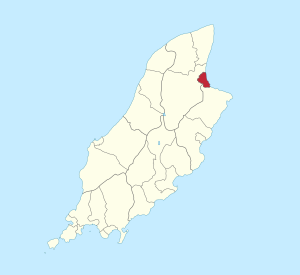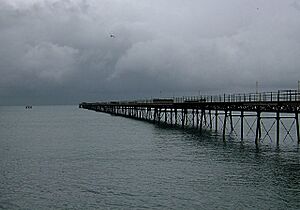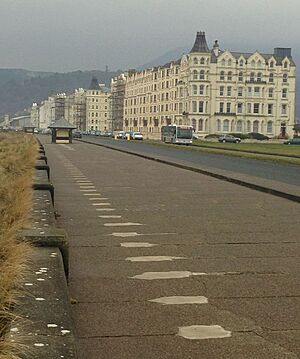Mooragh Internment Camp facts for kids
Mooragh Camp was a special place in Ramsey, on the Isle of Man, during World War II. It was an internment camp, which means it was a place where people were held, often because they were from countries that were at war with Britain. This camp was open from May 1940 until September 1945. It was the first camp of its kind on the island since World War I.
Contents
Setting Up the Camp
In May 1940, people living along Mooragh Promenade in Ramsey received official letters. These letters told them that their homes would be taken over by the government to create a camp for "enemy aliens." An "enemy alien" was a term used for people living in Britain who were citizens of countries Britain was fighting against, like Germany or Italy. The residents had to move out quickly, leaving behind their furniture and other household items.
About thirty guesthouses and hotels along the promenade were used for the camp. Some nearby bungalows were also taken for the soldiers who would guard the camp. The camp even included the Mooragh golf course, which became a recreation area for the people held there.
A double fence made of barbed wire was put up around the camp. On the side facing the sea, the fence went almost to the sea wall, leaving a small path for the guards to patrol.
On May 26, 1940, 10 officers and 150 soldiers from the Royal Welch Fusiliers arrived in Ramsey. They came on a ship called the Castle Rushen, ready to guard the new camp.
The very next day, May 27, the soldiers stood guard at Queen's Pier. They were there to meet the first group of internees. A ship called the Princess Josephine Charlotte arrived with 823 men. These men were taken in groups from the pier and gathered along the South Promenade. Many local people came to watch. The guards then walked the men to the camp.
A local newspaper, the Courier, later wrote about the new arrivals. It said that most of the men were young or middle-aged. They carried their belongings in suitcases or bundles. Some looked well-off, while others seemed to have less. One man even had his dog with him, and another was carrying a fishing rod!
Camp Changes Over Time
Mooragh Camp changed as the war continued. New countries joined the war, and some internees were released if they were not seen as a threat to the Allies.
Around April 1941, many internees from another camp in Peel moved to Mooragh Camp. This happened because the Peel camp was being prepared for British fascists.
In November 1942, about 180 Finns moved to Mooragh Camp when a camp in Douglas closed. Many of these Finns were sailors captured from Swedish cargo ships. While some were friendly towards Britain, many others supported Nazi Germany. This made the camp more challenging as time went on.
By April 1943, Finns made up a quarter of the camp's population. The rest were Germans and Italians. Each nationality was given houses in different parts of the promenade, separated by barbed wire. The Finns were in 'F' Camp, the Germans in 'L' Camp, and the Italians in 'N' Camp. This setup remained until the camp closed on August 2, 1945.
Life Inside the Camp
Each guesthouse in the camp worked like its own small community. Internees took on different jobs, like being a leader, kitchen staff, cleaners, or cooks. Each house had a recreation room (which was the only heated room), a dining room, toilets, bathrooms, and bedrooms.
Each camp area also had special buildings for workshops. Here, internees could work as tailors, toy makers, or watchmakers. There was also a library that internees could use, along with a canteen, a wash-house, a drying room, and storage areas.
After a while, people on the island and the authorities became less suspicious of the internees. This led to internees being allowed to work outside the camps. Many worked on farms, helping to make up for the shortage of almost 800 local men who had joined the military by 1943.
Mooragh Camp was special because internees had free access to news from the very beginning. They received 36 copies of the Daily Mail and the Ramsey Courier every day.
Like other camps on the island, Mooragh Camp had its own newspaper, called the Mooragh Times. It published poems and other writings by internees in both German and English. They also published a booklet called Stimmen hinter Stracheldraht, which means "Voices behind Barbed Wire." This book was a collection of works from internees at Mooragh and other camps. One poem, "Mooragh, July 1940," by F. F. Beiber, showed how many internees felt:
Beyond barbed wire
The sea,
And the sun’s last fire
Burning up a tree
And a cottage on the green hill.
Gulls idle on the beach,
Then rise into the air and cry.
The field across the bay we cannot reach,
We can but pace our cage and let our hungry eye
Take in far loveliness which will
Remain
Beyond our sadness and beyond despair,
Beyond our stubborn hope, beyond our fair
And puzzled sense of justice. They will stand,
This bay, this pier, this beach, this sea,
This distant friendliness of wooded land -
To bid farewell to us when we are free.
Escape Attempts and Incidents
On October 15, 1941, three Dutchmen managed to escape from the camp. They were a civil air pilot and two officers from the merchant marine. They had planned their escape for two months, studying the guards' movements and building a ladder to get over the fence. They had to act quickly because they found out they were going to be moved to another camp the next day.
They found a small boat and paddled out to a yacht called the Irene. Even though the yacht was supposed to be unusable, they managed to steer it out of the harbor. They planned to sail to Ireland, but a very strong storm made it almost impossible. An extensive search was launched by land, sea, and air. The yacht was spotted by the RAF but not stopped. The three men eventually landed near Eskmeels in England, far off course. They were arrested and later returned to the Isle of Man to face charges for stealing the boat. They were sentenced to six months in prison on the island. After their release, they were sent back to internment, this time at Peveril camp.
By early 1943, there were many Finns in the camp. Their section of the camp sometimes had arguments and fights. On April 20, a 26-year-old Finnish man threw dirty water on a 36-year-old man. The older man reacted by using a knife, and the younger man sadly died. A crowd then attacked the older man, but he ran to the guards for protection. In the trial that followed, the man was found not guilty because he acted in self-defense. He was then returned to the camp.
Mooragh Camp also saw the last serious escape attempt on the island during the war. On March 11, 1945, two German men, aged 28 and 32, found a weak spot in the fence. They untwisted the wire and made a gap to slip through. Unlike other escapees, they took food with them. This allowed them to hide in the fields for a week without needing to contact anyone. After a week of cold and wet weather, during which up to 300 people searched for them, they walked into the Bride post office on March 18 and gave themselves up. They later admitted they knew they couldn't realistically get off the island.
Notable Internees
Some well-known people were held at Mooragh Camp, including:
- Peter Gellhorn (1912–2004), a conductor, composer, pianist, and teacher.
- Walter Joseph (1922–2003), a photographer.
- Rabbi Werner van der Zyl (1902–1984), who founded the Leo Baeck College.
See also
- Category: People interned in the Isle of Man during World War II





